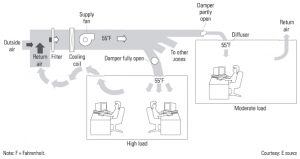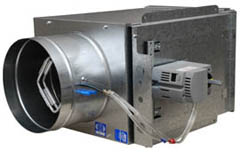Variable Air Volume Systems Currently available air distribution components, controls, and design strategies offer much more efficient designs than those installed and operating in many existing buildings. Today’s VAV systems can handle changing load requirements by varying the amount of heated or cooled air circulated to the conditioned space in response to varying heating or cooling loads. This reduces fan power requirements, which saves energy and costs.
VAV systems work either by opening or closing dampers or by modulating the airflow through mixing boxes powered by VAV fans as loads in various zones of the building change.
If, for example, more cooling in an area is required, the damper to that area is opened wider, increasing the flow of cold air until the desired temperature is reached. As the damper opens, static pressure in the duct drops, signaling the fan to increase air delivery. Conversely in this same example, if an area is too cool, the damper is slowly closed, reducing the flow of cold air.
Used in combination with variable-speed drives (VSDs), this reduction in flow results in a reduction in the fan power needed, saving energy. Converting an existing constant-volume system to a VAV system is a popular option for many building owners, because it allows the system to turn itself down in response to changing demand.


 Variable Air Volume terminal units regulate the flow of conditioned supply-air into occupied spaces, to assure that comfortable temperature levels are maintained.
Variable Air Volume terminal units regulate the flow of conditioned supply-air into occupied spaces, to assure that comfortable temperature levels are maintained.